|
|||||
FlyingRC.net is a
Veteran-Owned site.

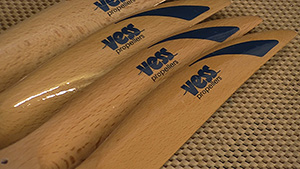 |
Vess Propellers look a little different because they are VERY different in how they produce thrust. There are complete new designs, not a little tweak here and there. Click image to enlarge |
Vess Propellers
Computer age engineering for better real-world performance
Text, photos and video by Tom Hintz
Flight video sequences by Clark Ponthier
Posted -1-7-2015
One of the things I noticed while changing over to gas engines was that there were a bunch of Vess Propellers on them wherever I went. Seeing them now and then would be a little interesting but seeing so many meant I needed to try them myself to see what this is all about.
The Basics
Note: While this review focuses on Vess Propellers for gas engines they offer a wide range of prop sizes for sport and electric planes as well.
Vess Propellers look different because they are designed and manufactured differently. For a long time there was a tried and true core design for RC propellers from which manufacturers would make small changes when trying to make their products stand out from the rest.
I should note that this whole idea was developed initially by Robert Vess and his concept continues on today. Vess Propellers began with a clean sheet of paper along with modern design tools used with an open mind to find the best contours for the job. It is important to realize that the propeller is one of the crucial systems that make our planes perform in the air.
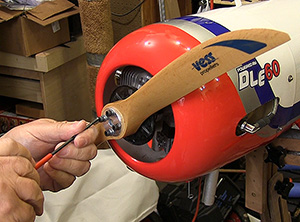 |
Everybody wants to be able to bolt on performance. Now you actually can, plus you can tune how the plane responds in different conditions or situations. Click image to enlarge |
The interaction of various engines and airframes was studied to guide the design of Vess Propellers to maximize their performance on those real world combinations. Vess found that rather than one consistent pitch they could improve performance of the prop by altering the pitch, width and shape of the blades over their length. Sophisticated computer tools were used to define the best combinations of those propeller properties to enhance performance in the real world environments. When the design was perfected it could be fed to CNC (computer numerically controlled) machines to be produced with extreme accuracy.
The distinctive curve of Vess Propellers comes from this sophisticated design and development. Vess optimized the chord, thickness, blade angle, and airfoil at many points along the length of the blades. This new design process also called for a non-linear twist distribution that further enhanced performance. Along with pure performance these unique blade shapes were tweaked to help control the noise generated.
This modern design process also makes the old diameter and pitch designations used to describe a propeller obsolete. Vess came up with an alphabetical designation that is much easier to use yet gives you a good indication of an individual props performance.
Say you have a typical aerobatic airplane in the 33% to 35% size, powered by a 100cc motor. A good starting point or baseline Vess Propeller would be a 27B, 27” diameter and B indicating a mid-range performance. “B” Vess Propellers are designed to provide great vertical pull and acceleration with reduced prop-generated noise. I use Vess B props for general flying on all of my planes.
With the same plane, put on a Vess Propeller 27A and the engine sees less load and vertical performance is softened which can be a big help when learning to hover or on a plane with which you do a lot of slower maneuvers. The “A” designation Vess Propellers are also helpful when the plane is heavier, less aerodynamic or has less power. The “A” props reduce load on the engine and let it turn in a more natural RPM range that reduces heat buildup in the engine.
Using the same principles, if you have a lighter, more aerodynamic or more powerful motor on that 33% to 35% plane the more aggressive, higher-loading 27C prop could provide a level of performance that would be hard to duplicate with traditional prop designs.
In my flying the Vess Propeller system lets me have a wider range of prop-related performance to choose from with fewer props. That means I carry a more reasonable number of backups which saves money.
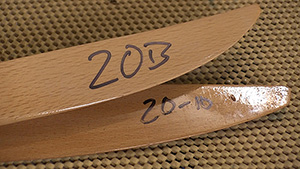 |
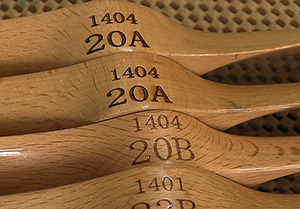 |
Put a Vess Propeller on top of a conventional one (left) and the blades begin to look very different. I get the same performance with the 20B as I did the 20X10 conventional but the engine seems to be working less and vertical performance is visibly greater with the Vess Propeller. The Vess numbering system (right) and the design they represent means I can carry fewer props to cover the same range of situations I needed several more conventional props to be ready. Click images to enlarge |
|
Measuring Performance
With traditional prop designs many pilots judged performance with a tachometer on the ground. The Vess Propellers design makes the tachometer readings less important because they are designed around in-flight performance. I suppose you could do rough RPM checks on the ground but the real way to determine the effectiveness of a Vess Propeller on your plane is to fly it. Watch for not only the effect on vertical performance but also response over the entire RPM range. I fly an Aeroworks 50cc Pitts Python ARF-QB with a DLE-60 Twin Engine and can easily see the difference between a Vess 23A and their 23B. I get a softer throttle response and a bit less vertical sensitivity with the 23A which is nice for slower aerobatics and hovering. Put the 23B on and the overall speed goes up and the increased vertical performance borders on scary.
Another aspect I like about the A series Vess Propellers is that they are great for breaking in a new or rebuilt engine. The reduced loading keeps temperatures down but there is plenty of performance to fly the plane safely and have some fun in the process. After break in the A series Vess Propeller remains useful for when you want to soften the plane up when that is more appealing for the conditions that day.
Sound Levels
The overall sound level created by a model is largely determined by the loudest component, more often than not the engine itself. And like anything else, an elevated sound level might be blamed on the wrong thing when sophisticated measuring and test protocols are not used.
The unique design of the Vess Propellers mean that they unload far less than traditional designs. That means the tips of the Vess Propellers are better able to resist reaching supersonic speeds where the most noise is made. Vess Propellers are designed to make full use of the available power in RPM levels below the sonic ranges.
At the Field
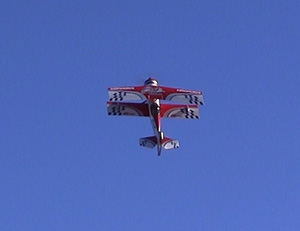 |
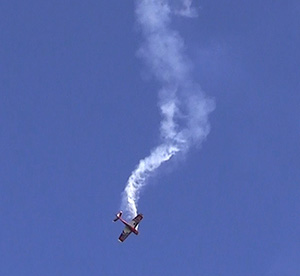 |
Put a 23A Vess Propeller on my 50CC Pitts (left) and things like hovering are easier because throttle response is softer and more controllable. I like a 23B Vess Propeller on my 91" Aeroworks 260 Freestyle Extra (right) because it has all of the snap and acceleration I need when tossing an 18lb airplane around. Click images to enlarge |
|
I have been flying Vess Propellers all summer and fall (2014) on my Aeroworks 30cc (DLE 40 Twin) Freestyle Extra 260 QB-L, Aeroworks 60cc (DLE 61) Freestyle Extra 260 QB-L and Aeroworks 50cc (DLE 60 Twin) Pitts Python ARF-QB. While I have tried traditional props and all of them the Vess Propellers in the A and B ranges constantly out-perform anything else I have tried.
Even on my Aeroworks 50cc Pitts Python ARF-QB the 23A Vess Propeller gives me far more vertical control when trying to hover this giant scale bi plane. I have no illusions of being anything more than a D & ½ pilot but the Vess Propellers help me look better because there is less sensitivity during maneuvers like hovering and harriers.
On a Pilot 26% YAK 54 powered by the DLE 40 Twin I was able to go down to a 20C Vess Propeller to gain ground clearance and still gain overall performance with lots more vertical over traditional 22X8 props I tried. In addition to the increased performance it was nice not having to watch for broken prop tips flying off during touch and goes with the smaller diameter Vess Propellers.
Conclusions
I got started with the Vess Propellers almost by accident. On a trip to a sort-of-local hobby shop, Anderson RC in Thomasville NC they did not have the size prop I wanted in my usual brand but did have the equivalent Vess Propeller. I bought a couple and when I flew the Vess the first time I was hooked. My experience with the Vess Propellers in the year since has done nothing but reinforce my liking these props.
As we all should be doing, I carefully balance all of my props. It didn’t take me long to realize that the Vess Propellers balanced easier and came out of the packages closer to balance than I was accustomed to.
So far the only problem I have had with Vess Propellers is finding a little bit of excess finish in the center hole of two props. I removed that and the props fit and balanced perfectly. I know, nit picking but it is technically a (easily solved) problem.
I have only flown the gas engine Vess Propellers but they are offering other ranges of props, all with the same design and manufacturing processes. They offer their Sport Series props in sizes from 9 inch to 18 inches in an S blade design for general flying. They have a line of electric props also in the 9 to 18 inch range, specifically designed for general electric powered planes.
Vess Propellers sell for between $23 for a 19” gas prop and $87 for their 32” gas model (1-7-2015). Not cheap but there is nothing cheap about them. These are very high quality props with a lot of research behind their design and high end machining employed to be sure you get consistent performance in the air.
Video Tour |
If your local retailer does not handle Vess Propellers (tell them to get on the stick!) you can get them from Anderson RC who I have since learned owns Vess Propellers! The contact info for Anderson RC is below and I suspect when you call you will see why I keep going back even though it is an hour drive away. And when you call, tell them FlyingRC.net sent you! (I want an Anderson RC T-shirt)!
Anderson R/C
1101 Mendenhall Street
Thomasville, NC 27360
Toll Free: (866) 929-0249
Phone: (336) 476-6917
http://andersonr-c.com/
http://www.vesspropellers.com/
Have a comment on this review? - Email Me!
All Flyingrc.net written, photographic and drawn materials are property of and copyright by Tom Hintz and Flyingrc.net 2013-2020 Materials cannot be used in any way without the prior written permission of the owner.
Privacy Statement


